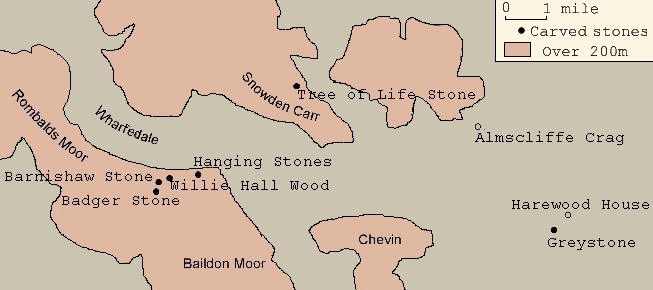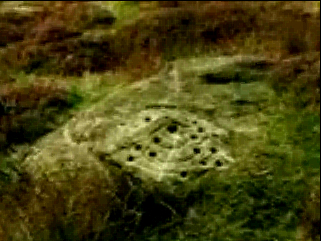
Figure 10: The sites of some of the featured rock art in mid-Wharfedale in relation to Almescliffe Crag.
Click to view individual panoramas.
Mid-Wharfedale is at the centre of the West Yorkshire group of carvings that are generally to be found on outcrops of Millstone Grit at the edge of upland regions overlooking the river valleys of the Aire, Wharfe and Washburn (figure 10). The area was chosen to contrast computer graphic visualisations of carved stones in wooded and open landscapes. This was because so many of the sites are in open moorland (it is much easier to transpose stones from open to wooded situations than the reverse). While recording these panoramas, however, a pattern of intervisibility became apparent, centred mostly on a large outcrop of gritstone. Again, the arguments for and against intervisibility are beyond this article but, at least for aesthetic reasons, the Almscliffe outcrop was chosen as the starting point for this section of the QTVR scene.

Figure 10: The sites of some of the featured rock art in mid-Wharfedale in relation to Almescliffe Crag.
Click to view individual panoramas.
Almscliffe is a huge outcrop of gritstone that dominates the whole of Mid-Wharfedale and, like Roughting Linn waterfall, cannot fail to have been regarded as significant by the rock carvers of this area. Certainly it has been much carved (and walked upon) since the 19th century so that no obvious prehistoric carvings can be seen. Nevertheless, it makes a good starting point for a QTVR view of the area allowing an excellent mental map of the whole mid-Wharfedale region to be generated. From here can be seen the Greystone, on the edge of the Harewood estate, the Tree of Life stone (figure 11) above the Washburn and surrounded by its own local group of ten or more carved outcrops, Hanging Stones and the Willie Hall Wood carving.


Figure 11 (left): The tree motif on the Tree of Life Stone.
Figure 12 (right): An artist's rendition of a 'shamanic' view of the Barnishaw Stone carvings.
Click on images for panorama views
Visible from Willie Hall Wood but probably not from Almscliffe, the Barnishaw Stone is carved with the rare 'ladder' markings, unique to West Yorkshire. The special quality of this stone and its carvings has resulted in the panorama image of it being chosen (together with that of the Badger Stone, slightly higher on the moor above it) for the application of more extensive image processing (figure 12). This is an attempt to investigate artistically aspects of what could be called 'shamanic vision' (see the discussion on 'entoptics').
© Internet Archaeology
URL: http://intarch.ac.uk/journal/issue8/larkman/10.html
Last updated: Mon Sep 25 2000